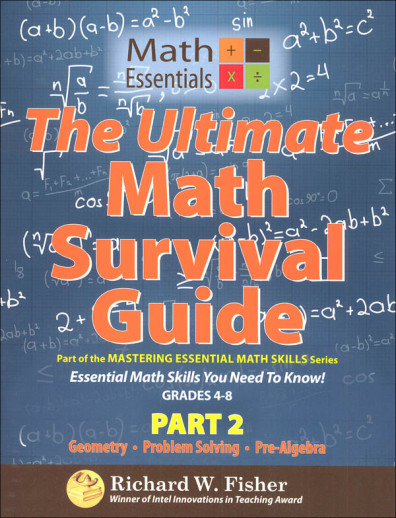We use cookies to make your experience better. To comply with the new e-Privacy directive, we need to ask for your consent to set the cookies. Learn more.
Ultimate Math Survival Guide Part 2
The Ultimate Math Survival Guide will help students in grades 4-8 really master the math they need to know. Each daily lesson contains three parts: Review Exercises, Helpful Hints, and Problem Solving, and together only takes approximately 15-20 minutes per day. This book is "Part 2" of 2, and contains problems grouped by concept: geometry, problem solving, and pre-algebra. 248 non-reproducible pages; consumable softcover workbook. Line-listed answer key and glossary included.
This newly edited version includes a handy glossary, a final review, and a Resource Center (which includes a glossary, reference pages of important symbols, multiplication table, common prime numbers, square roots, and fraction/decimals charts). It is a trusted publication used by tens of thousands of students. Students will master the skills necessary for success in intermediate math classes. Perfect for students who find math challenging and need additional support. Includes access to award-winning online video tutorials (1 per lesson) with an email signup. No Internet? This text is also available with DVD (#045527 Rainbow number), while supply lasts.
Book 1 and Book 2 offer five parts to each single-page lesson: speed drills, review exercises, teacher tips, new material, and a word problem, all of which fits into the 20-minute time frame. Students first complete the review exercises. These are generally only four problems per day that provide reinforcement of previously-learned math skills. Speed drills come next. These are always fact wheels with the center blank. You supply the "wild" addend or factor, based on your child's particular need for practice with certain fact families. New material is introduced next, along with "helpful hints" and examples. You should work the two sample problems with your child. Then, they complete the daily exercises (usually about ten) and word problem. Each book contains a "How to Use This Book" section, which makes it easy to use, and all solutions to exercises are included. Book 1 chapters include whole numbers; fractions; decimals; ratios, proportions and percents; geometry; number theory and algebra; integers; charts and graphs; probability and statistics; word problems and final review, all in 160 pages. Book 2 is divided into sections that cover more advanced aspects of whole numbers, fractions, decimals, percents, geometry, integers, charts and graphs, word problems, and review. An answer key is included in Books 1 and 2. Consumable, approximately 144 pgs.
Topical book lessons have 4 key parts. They begin with a review exercise covering previously learned concepts. Helpful hints introduce the new material, then two sample problems are to be worked by the adult and the student, then students do problems on their own for practice. The last item of each lesson is one word problem for students to solve. There are usually about 10 practice problems except in the problem solving book which may have fewer. Each book ends with a Final Review and a Final Test over the content of that specific book.
The instructional DVDs which accompany these books feature the author, Richard Fisher, "America's Math Teacher," and can be purchased separately or with the books. They include thorough explanations and demonstrations on a white board of the concept or concepts for each lesson. There is over 6 hours of instruction on each of the DVDs, and they are intended to accompany the Mastering Essential Math Skills books. The format of the DVDs remind me a bit of the Saxon DIVE CDS, but these are written on white board using a black marker and Mr. Fisher uses red at times to make it easier to follow his explanations. His instruction consists of the information found in the "Helpful Hints" sections of the book with elaboration. These DVDs are instruction only and you will need the corresponding book for each student. - Linda / Donna
For students who need more practice and review, these books cover all the basics before moving on to algebra. Using the same simple to understand format found in the Mastering Essential Math Skills Series, students will gain confidence as they master math essentials. Follow the five steps outlined in the front of each book for math success - Step 1: complete the review exercise and show your work; Step 2: introduce the new material using "Helpful Hints"; Step 3: work the two sample problems together (student & parent/teacher), then the student works independently; Step 4: go through the "Problem Solving" section and explain key words and strategies, then let the student solve the problem; Step 5: correct the work using solutions in the back of each book.
Ultimate Math Survival Guide, Part 1 includes whole numbers, integers, fractions, decimals, and percents. Ultimate Math Survival Guide, Part 2 includes geometry, problem solving, graphs, and pre-algebra topics. Each section in each book end with review and a test to check proficiency. Each book is 240+ pages and would work well for test prep, a summer refresher or extra practice and review. ~ Donna
| Product Format: | Paperback |
|---|---|
| Brand: | Math Essentials |
| Author: | Richard W. Fisher |
| Grades: | 4-8 |
| ISBN: | 9780984362967 |
| Length in Inches: | 11 |
| Width in Inches: | 8.5 |
| Height in Inches: | 0.625 |
| Weight in Pounds: | 1.6 |

